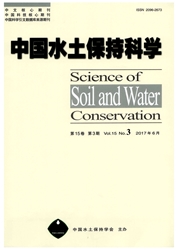

 中文摘要:
中文摘要:
充分认识黄土高原不同气候区降水时空分布特征,对于揭示该区域水土保持及自然环境变化的驱动因素至关重要。以黄土高原73个气象站点、1961—2014年的降水日值数据为基础,通过变差系数、集中度与集中期、Mann-Kendall检验和Kriging空间插值等研究方法,探讨黄土高原全区和4个气候分区的降水时空变化特征。结果显示:近50年间,黄土高原及各个气候区的年际降水量均呈波动下降趋势,年内降水均集中于夏秋季节,且存在集中度逐渐升高和集中期逐渐推后的现象。空间上降水由东南半湿润区向西北干旱区呈阶梯状递减,变差系数恰与之相反;集中度表现为由南向北递增,集中期则受地形影响显著,体现为平原和谷地地区早于高原和山地地区。因地理位置和季风强度的差异,各气候区年降水量及其波动幅度和集中性差异较大。该研究旨在揭示黄土高原降水的时空分布规律,为合理利用配置水资源、规划部署水土保持工作等,提供一定的参考。
 英文摘要:
英文摘要:
[Background]Investigations of the spatio-temporal characteristics of precipitation in different climatic regions of the Loess Plateau are very significant,which would be conducive to the explanation of the driving factors of environmental changes in the region. [Methods] Based on the daily precipitation data of 73 meteorological stations on the Loess Plateau from 1961 to 2014,this paper analyzed the spatiotemporal precipitation variations respectively in the whole Loess Plateau and the four climatic regions using mathematical statistics methods of coefficient of variation,concentration degree,concentration period,Mann-Kendall test and Kriging interpolation. [Results] Annual precipitation of the Loess Plateau and the four climatic regions fluctuated and declined slightly during the study period. The annual precipitation of the Loess Plateau ranged from 313. 6 mm to 657. 4 mm,with a decline rate of- 0. 79 mm / a. The annual precipitations in the whole Loess Plateau and 4 climatic regions were concentrated mostly in the summer and autumn seasons. For the whole Loess Plateau,the summer and autumn precipitation were 239. 4 mm and 108. 4 mm, respectively, which constituted 79% of the annual precipitation. Concentration period of precipitation in the whole Plateau mainly ranged from 13 July to 4September,with most periods( 68% of a year) concentrated in the period from 29 July to 13 August.Meanwhile,the concentration degree increased gradually during the period from 1961 to 2014,and theconcentration period postponed gradually. For the spatial characteristics of precipitation in the plateau level,it decreased gradually from the southeast( 810 mm) to the northwest( 130 mm),the annual precipitation of the four regions were in the order of semi-humid region cold and arid region semiarid region arid region. While the coefficient of variation of precipitation changed in an opposite way and ranged from 0. 13 to 0. 36. These all indicated that precipitation was influenced strongly by the geographic position. The con
 同期刊论文项目
同期刊论文项目
 同项目期刊论文
同项目期刊论文
 期刊信息
期刊信息
